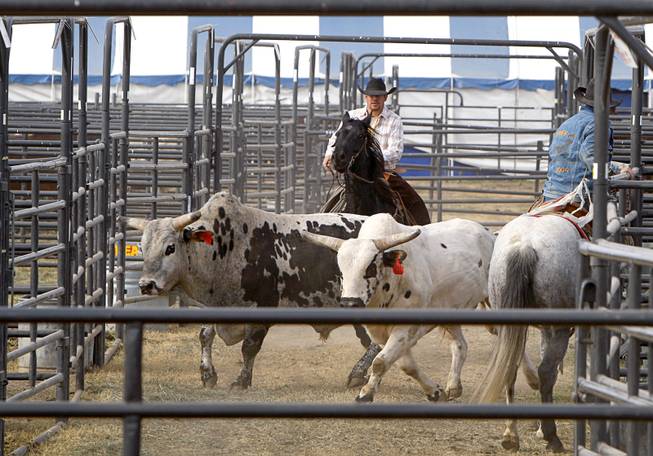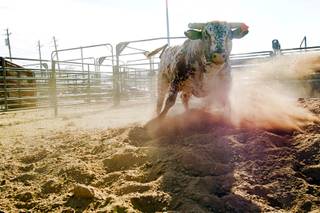
Luke Hutchison moves bulls to an exercise area at the National Finals Rodeo livestock area on UNLV campus Tuesday, December 4, 2012.
Wednesday, Dec. 5, 2012 | 2 a.m.
The massive bucking broncos and snorting bulls from the 2012 Wrangler National Finals Rodeo can pose a danger to participants, but security for the animals is in place as much for their safety as spectators'.
The bull that escaped a few years ago down a hallway inside the Thomas & Mack Center can speak to that. More on that incident later ...
For this year's rodeo, the 500 or so bulls, horses and calves began arriving Nov. 29, and they are housed within five layers of steel, 8-foot high fencing to keep them from harm and prevent them from escaping.
To keep the stars of the show calm, Todd Clawson, the associate director of the Thomas & Mack Center, said the animals arrive days early so they can get comfortable and be well rested.
“What you want to do is get them acclimated to the conditions here in Las Vegas, — make sure that from their travels they’re not road weary, they’re fresh,” Clawson said.
The animals are housed in corals and stalls on UNLV’s intramural fields near Harmon Avenue and Swenson Street, about 750 feet from the performance venue. To avoid organic hazards posed by large groups of animals, UNLV students will use the Rebels' practice field for activities.
The livestock is divided by type and usually kept in groups of three or four to a stall.
At all times, 12 to 15 off-duty police officers from various departments, including Metro Police and officers from Henderson, will be standing by to keep watch. The police aren’t specifically trained to handle livestock; they are hired mostly to protect the animals and monitor traffic coming in and out of the centralized animal housing area.
Clawson said the off-duty officers tend to plan their vacation days around the event so they can pitch in and earn some extra money.
Access to animals is controlled by the off-duty officers, who have a list provided by rodeo participants identifying who — including veterinarians and groomers — can have access to their animals.
Security also monitors the coming and going of the animals by checking the IDs of the handlers every time an animal is removed from the area.
Clawson has helped organize the event since he came to work at the Thomas & Mack Center in 1993, and one story stands out:
One day in a mostly empty Thomas & Mack Center, some cowboys were practicing with a bull in a circle of 36–inch-tall bike racks, but someone had forgotten to shut one of the gates in the arena. At once, the bull decided he was done with practice and leaped over the makeshift ring — a rare occurrence.
“It was probably over 2,000 pounds. I mean it was huge,” Clawson said.
The bull dashed out of the gates and into a hallway, his broad head so wide that his horns scraped against both walls, ripping down pictures and posters as he tore toward the locker rooms. One staff member was nearly run over but managed to duck inside a doorway.
After 10 minutes, the bull stopped on its own but was too big to turn around in the narrow hallway. By the time the cowboys found a horse to help pull the bull backwards and back into the arena, the whole debacle had lasted about 30 minutes.
“It was funny, but you worry about the damage a bull could do,” he said.
This year, they’ll make sure to keep the running of the bulls out of the hallway.


Join the Discussion:
Check this out for a full explanation of our conversion to the LiveFyre commenting system and instructions on how to sign up for an account.
Full comments policy